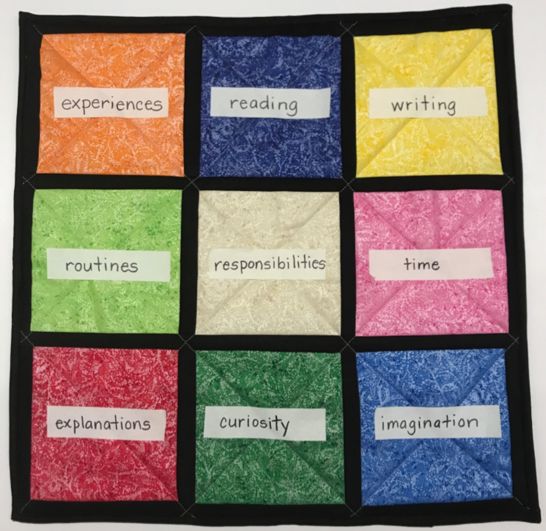“It is not what you do for your children, but what you have taught them to do for themselves, that will make them successful human beings.” —Ann Landers
One of my favorite memories of my children and grandchildren is the love they had for their blankets. I am reminded of those memories every time I come across the book The Quilt Story, by Tory Johnson and Tomie de Paola, about a young girl who finds a quilt that helps her feel secure in a new home.
I have also found that the image of a quilt is a good way to convey nine ideas that can help parents give their children security and confidence not only in the present, but also in the future. Each idea can be thought of as one square in the quilt.
1. EXPERIENCES
What it means: Engage your children in a variety of activities, and as you do so talk to them, listen to what they have to say, and ask questions.
Things you can do: Share cooking time, go to the park, play games, visit relatives, go to community events, visit museums.
2. SHARED READING
What it means: Take time to read together.
Things you can do: Rhyming books help children learn to recognize similar sounds. Story books can be retold in their own words. Nonfiction teaches about the world. When you read with your child, take time to ask and answer questions about what you’re reading, and to point out letters and words that your child can learn to recognize.
3. SHARED WRITING
What it means: Take time to write together.
Things you can do: Create a menu, a grocery list, or an invitation. Have your child draw a picture about something you did together and tell you what to write about it.
4. ROUTINES
What it means: Maintain a consistent daily and weekly schedule of events.
Things you can do: Establish routines that your children can depend on. Create a pictorial chart for the day for young children: wake up, brush teeth, eat breakfast, go to school, etc.
5. RESPONSIBILITIES
What it means: Provide opportunities for children to contribute to the maintenance of your household.
Things you can do: Show your child how to fold small towels, sort socks, pick up and put away toys, and place dirty clothes in a hamper.
6. TIME
What it means: Dedicate time each day to focus on your children.
Things you can do: Plan for times throughout the day just to talk and listen to your child, making sure he knows his thoughts and feelings are important.
7. EXPLANATIONS
What it means: Take time to explain the world around your children.
Things you can do: Talk about what you see: the weather, the seasons, the way people feel, life cycles of plants, animal characteristics and behaviors, etc. If your child wants to learn more about something, go to the library together to find appropriate books.
8. CURIOSITY
What it means: Encourage children to ask “Why?” and “How” questions.
Things you can do: Help children put things together and take them apart; allow them to ask questions. Respond not only with answers but also questions: “What do YOU think will happen if …?”
9. IMAGINATION
What it means: Provide children with opportunities to be thoughtfully creative and inventive.
Things you can do: Begin stories for your child that she has to finish. Ask questions like, “What do you think that cloud looks like?” Encourage your child to create her own art or construction projects with available materials. Provide books that support thinking inventively.
Not only are these activities comforting and enjoyable for children, but they also help build the foundation for what children need to know and do to be successful in school. For example, children need to understand how the school day is organized (routine) and what they need to do for homework (responsibilities). They will need to read assignments and write about what they think (shared reading and writing). They will need to explain topics they have researched (explanations) and create original presentations, stories, or art works (imagination). Your children will also need to make presentations about events and places (experiences) and investigate topics they want to find out more about (curiosity).
Altogether, this quilt of nine ideas—which I call a “blanket of success" (shown below)—offers guidelines that can help any parent teach their children to do things “for themselves, that will make them successful human beings.”

Blanket of Success: “What you have taught them to do for themselves, that will make them successful human beings.”
* Rebecca A. Palacios, Ph.D., is a Senior Curriculum Advisor for Age of Learning, Inc., the company that produces the ABCmouse.com Early Learning Academy website and ABCmouse mobile apps.